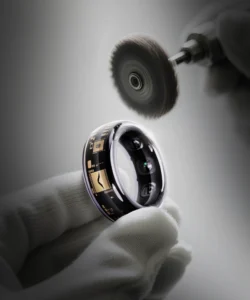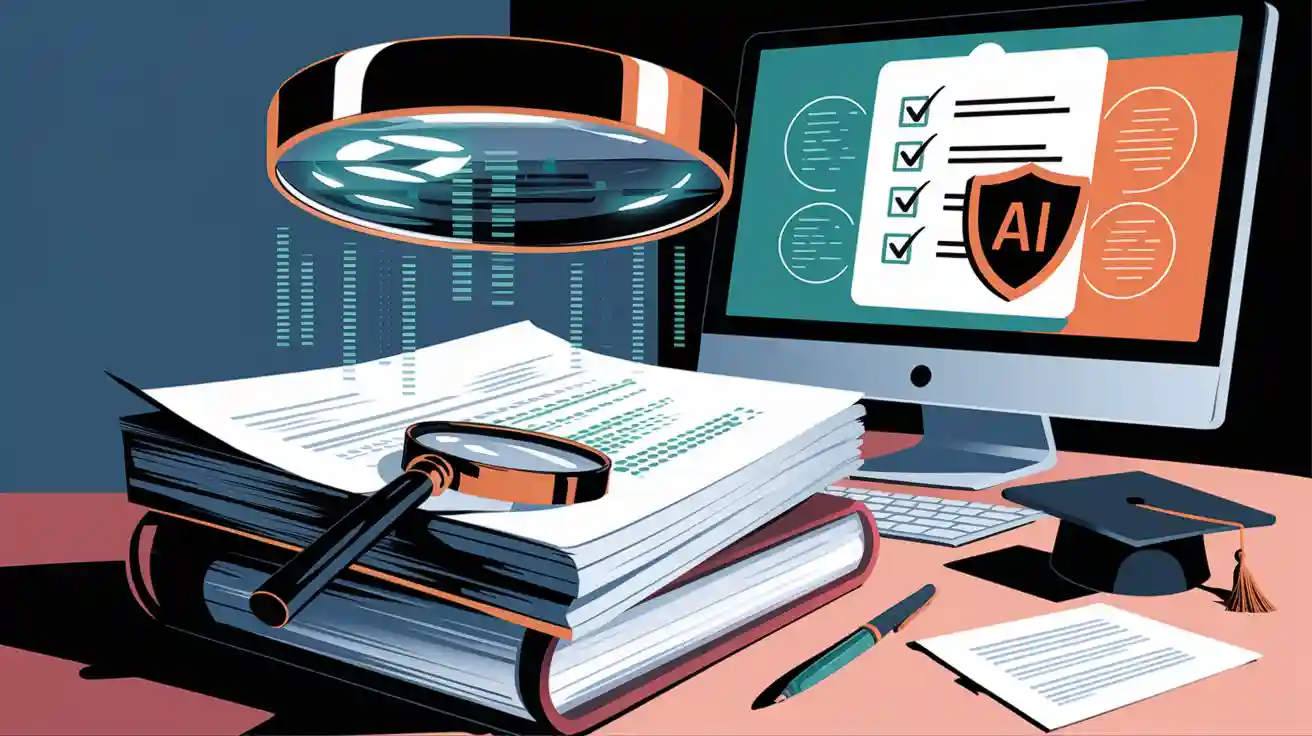
You face a new challenge in 2025 as nearly half of climate change research abstracts use ai-generated text.
Academic integrity now demands reliable ai paper detector tools. Studies reveal that ai writing tools increase plagiarism and make it harder to spot ai-generated content. Protecting integrity means staying alert as ai and plagiarism methods evolve.
Key Takeaways
-
AI paper detectors help protect academic honesty by spotting AI-generated and plagiarized content in essays and research papers.
-
Top tools like Originality.ai, Turnitin, and Copyleaks offer high accuracy, easy integration, and support for multiple languages and formats.
-
Use AI detectors alongside human judgment to reduce errors and ensure fairness, while respecting student privacy and ethical concerns.
Top AI Paper Detectors
Leading Tools in 2025
You need reliable ai detectors to protect academic integrity in 2025. The market for ai paper detector tools has grown rapidly. The top five companies—Turnitin, Copyleaks, Smodin, Originality, and Plagscan—now control over 60% of the market. These tools help you spot ai-generated content in essays, research papers, and assignments. The education sector leads in adopting these solutions, especially in North America and Western Europe. Asia-Pacific is also seeing fast growth in the use of ai detection software.
Here are the ten best ai detection tools you should know:
-
Originality.ai
This ai paper detector stands out for its accuracy and low false positives. It offers three detection modes, plagiarism checking, and API access. You can trust its originality reports for both student and research writing. -
Copyleaks
Copyleaks combines plagiarism detection with ai style analysis. It integrates with learning management systems and provides flexible plans for teachers and researchers. -
Turnitin AI Detection
Turnitin is trusted by over 30,000 institutions. Its AI Text Verifier checks for both similarity and originality, making it a staple in academic ai detection software. -
GPTZero
GPTZero is open-source and uses statistical methods for ai content detection. It does not require private datasets and is customizable for different academic needs. -
Winston AI
Winston AI detects subtle changes in text patterns. It gives real-time originality rankings, which help you assess student work quickly. -
Writer.com
Writer.com offers continuous originality checks and semantic similarity detection. It works well for repeated content checks in academic assignments. -
Crossplag
Crossplag uses machine learning to detect ai-generated content. It compares submissions with a large database of printed materials. -
BrandWell
BrandWell analyzes linguistic patterns for ai detection. It offers tailored integration and pricing for academic and research environments. -
Smodin
Smodin provides customizable ai ghostwriting detection. It uses premium logic for advanced detection and is popular in higher education. -
Quill.org
Quill.org flags ai content by analyzing style and semantics. It compares new submissions with past work, making it affordable for classroom use.
Note: These ai detectors focus on text content, which accounts for over 90% of the market’s revenue. You can rely on them for essays, research papers, and other academic writing.
Features Overview
When you compare the best ai detection tools, you should look at their accuracy, integration, privacy, and cost. Independent evaluations in 2025 highlight Originality.ai as the most effective ai paper detector. It achieves over 99% accuracy with low false positives. Copyleaks also ranks high for reliability and seamless integration with educational platforms. Turnitin remains a top choice for rigorous plagiarism and ai detection standards.
The table below summarizes the key features of the leading ai detectors for academic use:
|
Tool Name |
Key Features |
Academic Use Focus |
Pricing/Notes |
|---|---|---|---|
|
Originality.AI |
Analyzes writing style and context; provides plagiarism and originality reports |
Enhances academic integrity |
Free plagiarism and originality reports |
|
GPTZero |
Open-source; uses statistical methods; >95% accuracy |
Transparent, customizable AI detection |
No private datasets required |
|
Turnitin |
Trusted by 30,000+ institutions; AI Text Verifier for similarity and originality checks |
Rigorous plagiarism standards |
Widely adopted in academia |
|
Copyleaks |
Combines plagiarism detection with AI style analysis; free and paid packages |
Flexible plagiarism checks with customization |
Free basic, paid advanced features |
|
Winston AI |
Detects subtle text pattern changes; real-time originality ranking |
Useful for student assessments |
Real-time originality rankings |
|
Writer.com |
Continuous originality checks; semantic similarity detection |
Integrated scanning for academic assignments |
Focus on repeated content checks |
|
Crossplag |
Machine learning to detect AI content; compares with extensive printed material database |
Maintains content integrity in education |
Supports educational settings |
|
BrandWell |
Analyzes linguistic patterns for AI detection; tailored integration and pricing |
Effective for publishing and research environments |
Tailored pricing for academia |
|
Smodin |
Customizable AI ghostwriting detection; premium logic for specific algorithms |
Advanced configurable AI detection |
Premium options available |
|
Quill.org |
Flags AI content by style and semantics; compares with past submissions |
Affordable for classroom use |
Starts at $9 monthly |
You should also consider the accuracy of each ai detector. Benchmark studies show that Originality.ai leads with near-perfect accuracy, especially in detecting paraphrased and adversarial content. Turnitin AI follows closely, while Sapling and GPTZero offer strong but slightly lower performance.
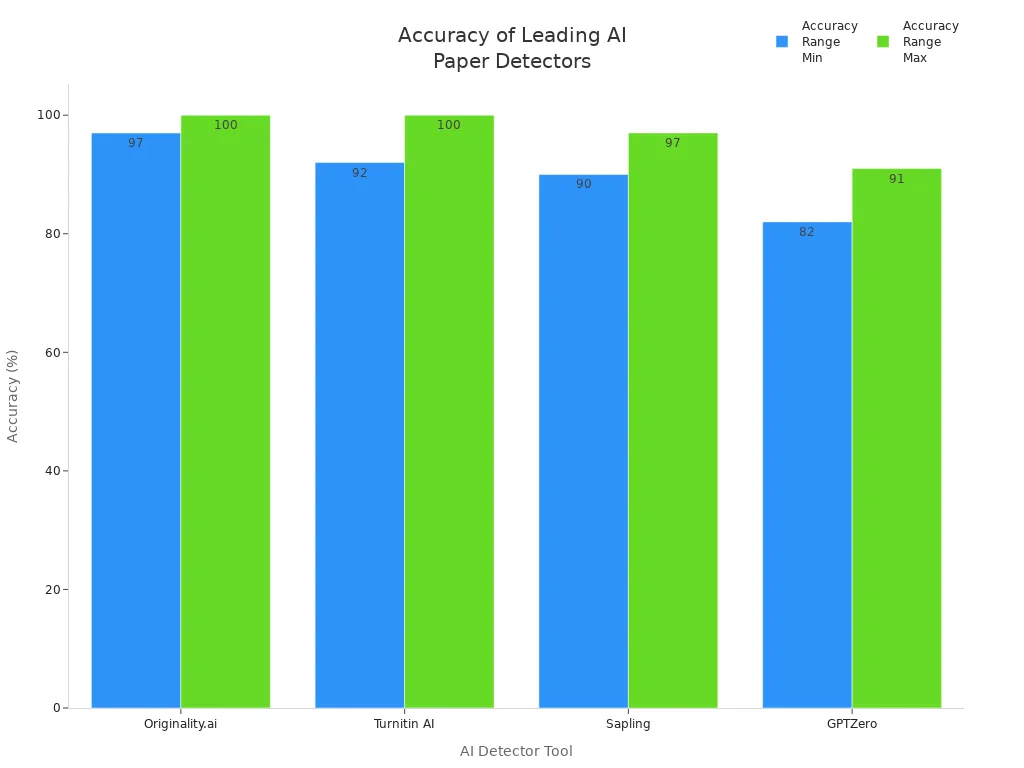
Originality.ai achieved 85% accuracy on base datasets and almost 97% on paraphrased content. In biomedical literature, it showed 100% sensitivity and 95% specificity. For STEM student writing, it classified 98% of ai-generated essays correctly, outperforming human evaluators. Copyleaks and Turnitin also provide high accuracy and practical integrations, making them reliable choices for teachers and researchers.
You can use these ai detectors for a range of academic needs. They support plagiarism detection, originality reports, and integration with learning management systems. Some, like GPTZero and Winston AI, offer open-source or real-time features. Others, such as Smodin and BrandWell, provide advanced configuration for specific academic or publishing requirements.
Tip: When choosing an ai detection service, look for transparency, confidence scores, and low false positive rates. These features help you trust the results and maintain academic integrity.
The best ai detection tools in 2025 give you the power to uphold originality and fairness in your classroom or research. By understanding the strengths of each ai content detector, you can select the right solution for your needs.
How AI Detection Tools Work
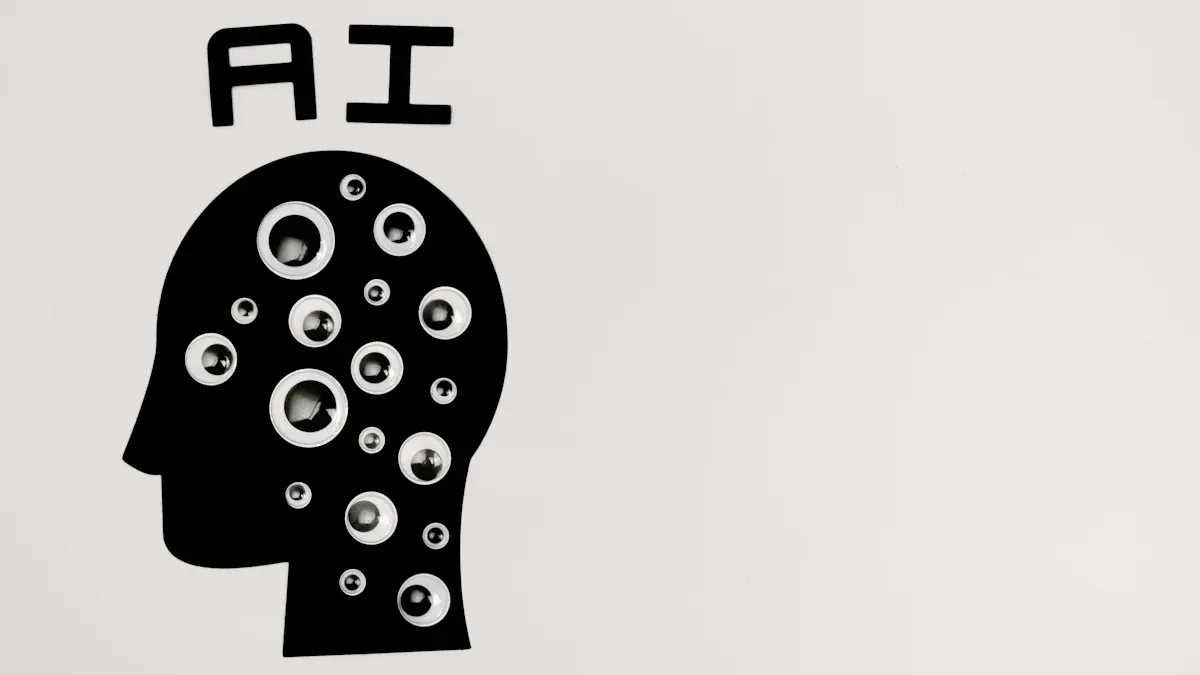
Detection Technologies
You rely on advanced ai detection tools to spot ai-generated text in academic writing. These tools use a mix of linguistic analysis and machine learning. They break down your text into features like sentence length, vocabulary richness, and punctuation. Machine learning models then look for patterns that match ai-generated content. For example, ai writing often shows smoother sentence flow and higher predictability, while human writing appears more varied and less predictable.
Most ai detection tools use algorithms such as n-grams and syntax analysis. They measure perplexity and burstiness—two features that help tell if a text is written by ai or a person. Perplexity checks how predictable the text is, and burstiness looks at the variation in sentence structure. Some tools, like Turnitin and GPTZero, score your text to show the likelihood of ai authorship. Watermarking can also mark ai-generated text, but paraphrasing can defeat this method.
Researchers have built benchmark datasets and fine-tuned language models to improve ai writing detection tools. Studies show that combining linguistic analysis with machine learning increases accuracy. For example, deep learning models like BERT and DeBERTa can reach over 97% accuracy in detecting ai-generated content.
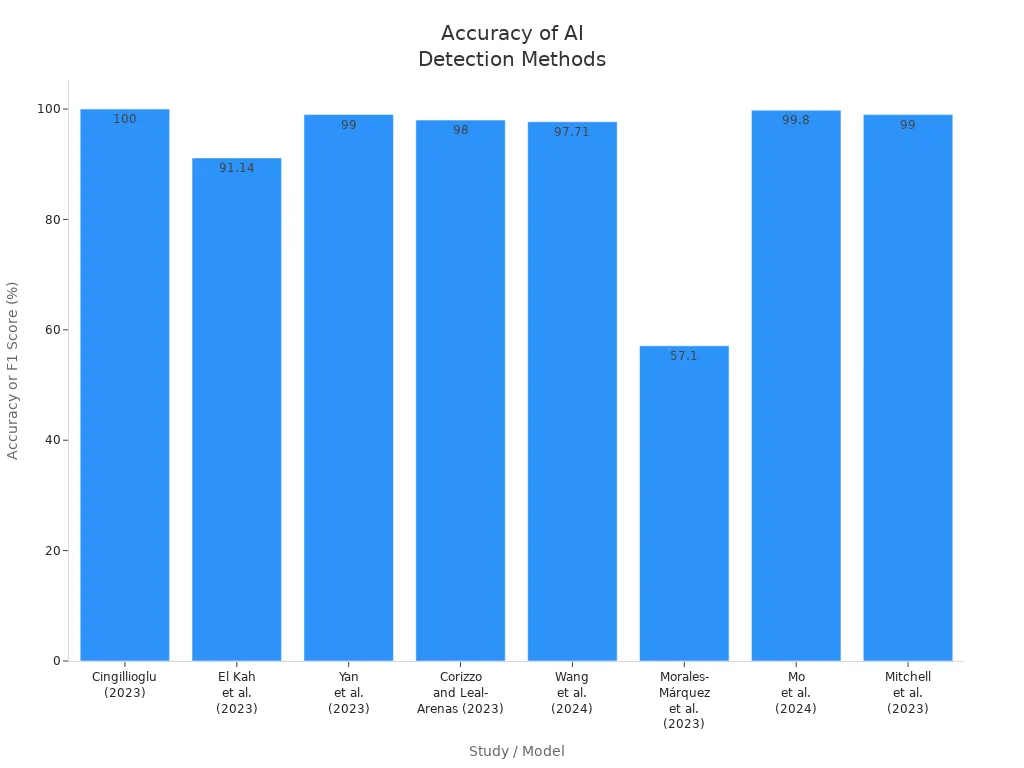
Importance for Academic Integrity
You need ai detection software to protect academic integrity in 2025. As ai-generated content becomes more common, detecting ai-written content helps you keep your classroom or research fair. These detection tools make sure students and researchers submit original work. They also help you spot when someone tries to pass off ai-generated text as their own.
By using ai text detection tools, you support honesty and trust in education. You can rely on these tools to adapt as ai writing grows more advanced. This keeps your standards high and your academic environment strong.
Comparing AI Detectors and Plagiarism Checkers
Accuracy and Reliability
You need to know how ai detectors and plagiarism checkers compare in detection accuracy. Ai detectors use advanced methods like deep learning and semantic analysis. These tools can spot paraphrased and disguised plagiarism, which traditional plagiarism checkers often miss. Plagiarism checkers rely on string matching and database comparisons. This works well for exact matches but struggles with ai-generated content or reworded text.
Here is a table showing the accuracy and strengths of popular plagiarism checkers:
|
Plagiarism Checker |
Accuracy (%) |
Strengths |
Limitations |
|---|---|---|---|
|
JustDone |
88 |
AI-aware scanning; detects reworded and paraphrased text |
Best for essays, short research, AI-assisted writing |
|
Grammarly |
76 |
Compares against open web content |
Does not cover academic databases |
|
Chegg |
62 |
Quick checks for general homework |
Misses paraphrased or AI-generated content |
|
QuillBot |
68 |
Casual use, surface-level checks |
May miss AI-rewritten phrases |
|
Turnitin |
93 |
Large academic archive, widely used |
Higher cost, traditional approach |
|
Scribbr |
96 |
Checks academic publications, student work, journals |
Strong for thesis and final reports |

Ai detectors often reach above 90% detection accuracy, especially for paraphrased or ai-generated content. Plagiarism checkers like Turnitin and Scribbr perform well for traditional plagiarism but may not catch advanced ai writing.
Supported Content Types
You will find that most ai detectors focus on essays, academic papers, and general text. Tools such as Copyleaks and GPTZero handle multiple languages and formats. Copyleaks supports over 100 languages and many file types, including code. Originality.ai supports 15 languages and focuses on high detection accuracy for text. Plagiarism checkers like Grammarly and Scribbr support common formats such as PDF, .docx, .odt, and .txt. These tools work best for written academic content, not code.
-
Ai detectors: essays, research papers, general text, some code (Copyleaks)
-
Plagiarism checkers: essays, academic papers, student documents, multiple file formats
Integration and Usability
You want tools that fit smoothly into your workflow. Ai detectors and plagiarism checkers now offer strong integration with learning management systems. Copyleaks provides plugins for platforms like Schoology and supports real-time scanning. Many tools offer interactive reports, analytics, and secure data handling. Originality.ai stands out for its simple interface and strong privacy controls. You can access these tools across devices, making them easy to use for both teachers and students.
Tip: Choose ai detectors or plagiarism checkers that support your preferred file formats and integrate with your LMS for the best experience.
|
Aspect |
AI Detectors |
Traditional Plagiarism Checkers |
|---|---|---|
|
Detection Methods |
NLP, semantic analysis, deep learning, pattern recognition |
String matching, database comparison |
|
Detection Accuracy |
Above 90%, strong for paraphrased and ai-generated content |
Lower for paraphrased or heavily modified text |
|
Content Types Supported |
Essays, research papers, general text, some code (Copyleaks) |
Essays, academic papers, student documents |
|
Up to 100+ languages (Copyleaks), 15 (Originality.ai) |
Limited multilingual support |
|
|
Integration |
Seamless LMS plugins, real-time scanning, analytics |
LMS plugins, basic analytics |
|
Usability |
Simple interfaces, privacy controls, device compatibility |
Familiar interfaces, strong for traditional plagiarism |
You can see that ai detectors offer more advanced ai plagiarism detection and better support for detecting plagiarism in modern academic writing.
Choosing the Right AI Detector
Key Features to Consider
When you evaluate an ai detector, you should focus on features that support fairness and accuracy. Many ai writing detection tools can produce false positives, especially for non-native English speakers. This can raise equity concerns in your classroom. You need to look for tools that combine high detection accuracy with real-time feedback and support for multiple languages. Human oversight remains important, so you should not rely only on automated results.
Here are some key features to look for:
-
High detection accuracy for both ai-generated and paraphrased content
-
Easy-to-use interface with instant feedback
-
Multi-language support for diverse classrooms
-
Plagiarism detection, including paraphrasing and cross-language checks
-
Strong privacy and data protection policies
-
Educational support, such as guidance on ethical writing
|
Feature |
Importance for Academic Use |
Example Tools |
|---|---|---|
|
Detection Accuracy |
Reliable identification of ai-generated content, critical for trustworthiness |
Originality.ai, GPTZero |
|
Ease of Use & Real-time Feedback |
Smooth user experience and instant results |
Turnitin, Yomu AI |
|
Multi-language Support |
Detection across different languages, important for diverse environments |
ContentDetector.AI |
Tip: Combine multiple ai detection tools and use them early in your academic workflow to improve reliability and fairness.
Matching to Academic Needs
You should match ai detection tools to your specific academic needs. Teachers often use ai writing tools to check for sudden changes in student writing style. You can require drafts or verbal explanations to support your findings. Remember, ai detection tools should not be your only method for identifying ai misuse. Human judgment and clear institutional policies play a key role.
-
Use ai writing detection tools as one part of your review process.
-
Educate yourself and your students about the strengths and limits of ai detection.
-
Prioritize learning and originality over punishment.
-
Protect student privacy by choosing tools with strong data protection.
By considering these factors, you can select an ai detector that fits your classroom or research environment and supports academic integrity.
Challenges with AI Paper Detectors
False Positives and Negatives
You may notice that AI paper detectors sometimes make mistakes. These mistakes fall into two main types: false positives and false negatives. A false positive happens when the tool marks a human-written paper as AI-generated. A false negative means the tool misses AI-generated text. Both errors can cause problems in your classroom or research.
Common causes of these errors include:
-
Short or incomplete texts, which make it hard for detectors to analyze patterns.
-
Formulaic writing, such as recipes or poetry, which can confuse the tool.
-
Texts from domains not well-represented in the detector’s training data.
-
Distinctive writing styles or non-native English, which may trigger false positives.
Research shows that literature sections in academic papers often get flagged by mistake. Non-native English speakers and students with unique writing styles face a higher risk of unfair accusations. These issues can create anxiety and distrust in your academic community.
To reduce false detection rates, you can use several AI detectors together. Studies show that combining three tools, especially including Copyleaks, brings the false positive rate close to zero. This approach helps you make fairer decisions and protects students from wrongful accusations.
Ethics and Privacy
Ethical concerns play a big role in using AI paper detectors. The table below highlights key issues:
|
Ethical Concern |
Description |
Affected Groups |
Consequences |
|---|---|---|---|
|
False Positives |
Human-written essays flagged as AI-generated |
All students, especially first-years |
Emotional harm, academic penalties, lost trust |
|
Disproportionate Impact |
Higher false flags for non-native, Black, and neurodiverse students |
Marginalized student groups |
Unfair accusations, worsened educational inequity |
|
Bias Against Patterns |
Detectors misread certain dialects or styles |
Students using non-standard dialects |
Discrimination, unfair grading |
|
Privacy Concerns |
Student work stored without clear consent |
All students |
Legal risks, loss of trust, copyright issues |
|
Reliability Issues |
Difficulty in telling AI from human writing |
All students |
Uncertainty, risk of wrongful accusations |
You should also consider privacy. Some detectors store student papers in large databases without clear consent. This practice raises legal and ethical questions about intellectual property and student rights. Experts recommend that schools explain how they use these tools and protect student data. As AI writing evolves, you need to stay updated and use these tools carefully to maintain fairness and trust.
You play a key role in upholding integrity by using an ai paper detector as part of a broader process. Update your policies, select tools that fit your needs, and combine technology with human review. Stay alert and adapt as AI and academic writing evolve, ensuring fairness and transparency in your academic community.
FAQ
How accurate are AI paper detectors in 2025?
You can expect top AI detectors to reach over 95% accuracy. Results may vary based on text length, subject, and writing style.
Can AI detectors replace human judgment?
You should not rely only on AI detectors. Use your own judgment and review flagged papers for context and intent.
Do AI detectors keep my students’ work private?
Most leading tools protect student data. Always check privacy policies before uploading sensitive documents.
Tip: Choose AI detectors with clear privacy statements and strong data protection.








